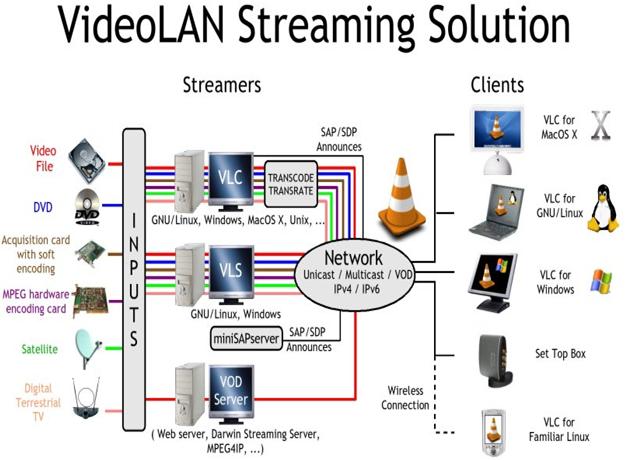Documentation:Streaming HowTo/Streaming, Muxers and Codecs
Contents
Introduction
Overview
VideoLAN is a complete software solution for video streaming, developed by students of the Ecole Centrale Paris and developers from all over the world, under the GNU General Public License (GPL). VideoLAN is designed to stream MPEG videos on high-bandwidth networks.
The VideoLAN solution includes:
- VLS (VideoLAN Server), which can stream MPEG-1, MPEG-2 and MPEG-4 files, DVDs, digital satellite channels, digital terrestrial television channels and live videos on the network in unicast or multicast
- VLC (initially VideoLAN Client), which can be used as a server to stream MPEG-1, MPEG-2 and MPEG-4 files, DVDs and live videos on the network in unicast or multicast ; or used as a client to receive, decode and display MPEG streams under multiple operating systems
Here is an illustration of the complete VideoLAN solution:
More details about the project can be found on the VideoLAN Web site.
VideoLAN software
VLC Media Player
VLC works on many platforms: Linux, Windows, Mac OS X, BeOS, *BSD, Solaris, Familiar Linux, Yopy/Linupy and QNX. It can read:
- MPEG-1, MPEG-2 and MPEG-4 / DivX files from a hard disk, a CD-ROM drive, ...
- DVDs and VCDs
- from a satellite card (DVB-S)
- from a camcorder (DV)
- MPEG-1, MPEG-2 and MPEG-4 streams from the network sent by VLS or VLC's stream output
VLC can also be used as a server to stream:
- MPEG-1, MPEG-2 and MPEG-4 / DivX files,
- DVDs,
- from an MPEG encoding card,
- from a camcorder DV,
to:
- one machine (i.e. to one IP address): this is called unicast,
- a dynamic group of machines that the clients can join or leave (i.e. to a multicast IP address): this is called multicast,
in IPv4 or IPv6.
To get the complete list of VLC's possibilities on each platform supported, see the VLC features page.
Note: VLC doesn't work on Mac OS 9, and probably never will.
Mini-SAP-server
You can add a channel information service based on the SAP/SDP standard to the VideoLAN solution. The mini-SAP-server sends announces about the multicast programs on the network in IPv4 or IPv6, and VLCs receive these annouces and automatically add the programs announced to their playlist.
The mini-SAP-server works under Linux and Mac OS X.
Muxers and codecs
What is a codec ?
To fully understand the VideoLAN solution, you must understand the difference between a codec and a container format.
A codec is a compression algorithm, used to reduce the size of a stream. There are audio codecs and video codecs. MPEG-1, MPEG-2, MPEG-4, Vorbis, DivX, ... are codecs.
What is a container format ?
To start off, think of a container format as a standard shipping box. You get a box in the mail and you think, "Cool! What's inside?" You don't really care about the box itself, you care about what's in that box. The problem? You can't see into the box. So what do you do? You get a knife and cut it open.
A container format follows this same basic idea. It contains one or several streams already encoded by codecs. Very often, there is an audio stream and a video one. AVI, Ogg, MOV, ASF, MP4 ... are container formats. The streams contained can be encoded using different codecs. In a perfect world, you could put any codec in any container format. Unfortunately, there are some incompatibilities. You can find a matrix of possible codecs and container formats on the features page.
Encoding a video
This is the step where you are going to create the shipping box.
- Encode your file. This means compressing a file, whether it is audio or video, to another format that normally takes up less physical drive space than the previous format. Common video encoding methods are DivX, MPEG-1, MPEG-2, MPEG-4 ... most common audio encoding method is MP3 or ogg-vorbis.
- Mux (or multiplex). This means joining separate parts of the video (or streams) into one file.
Playing a video
Now that you have your shipping box, you need to open it before you can see the content. That's exactly what VLC will do. To decode a stream, VLC first demuxes it. This means that it reads the container format and separates audio, video, and subtitles, if any. Demuxing files doesn't weaken the video or audio quality, neither does it do anything for them; it simply saves them into separate files, each containing one element of the original file. Then, each of these is passed to a decoder that does the mathematical processing to decompress the stream.
There is a particular thing about MPEG:
- MPEG is a codec. There are several versions of it, called MPEG-1, MPEG-2, MPEG-4, ...
- MPEG is also a container format, sometimes referred to as MPEG System. There are several types of MPEG: ES, PS, and TS.
For instance, when you play an MPEG video from a DVD, the MPEG stream is actually composed of several streams (called Elementary Streams, ES): there is one stream for video, one for audio, another for subtitles, and so on. These different streams are mixed together into a single Program Stream (PS). So, the .VOB files you can find in a DVD are actually MPEG-PS files. However, this PS format is not adapted for streaming video through a network or by satellite. So, another format called Transport Stream (TS) was designed for streaming MPEG videos through such channels.
Please read the Documentation Editing Guidelines before you edit the documentation
